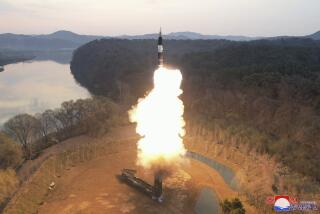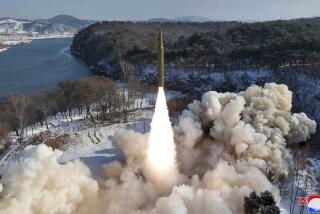Failed Test Deals a Setback to a National Missile Defense
- Share via
WASHINGTON — The Pentagon’s newest anti-missile weapon failed its fifth consecutive flight test Tuesday, deepening doubts about it and raising broader questions about how quickly the Pentagon can deploy a larger--and more controversial--system to shield the entire nation from missile attack.
The Army’s THAAD system, aimed at protecting troops from Scuds and other short- and medium-range missiles, spun out of control and crashed into the desert two miles from the launch pad at the White Sands Missile Range in New Mexico. The test was designed to see whether the missile could knock down another missile while both traveled at speeds of 11,000 miles per hour.
The mishap, whose cause has not been determined, means that after 15 years and $50 billion of spending, the most advanced outgrowth of President Reagan’s “Star Wars” plan remains unworkable.
And while the Pentagon said that it would not slow the THAAD program, the failure was a painful public relations setback for lawmakers who are pushing even now in Congress to force acceleration of what they see as the Clinton administration’s dangerously slow efforts to protect the nation from a spreading missile threat.
A GOP proposal that has 50 co-sponsors and is scheduled for a Senate vote today would force the administration to deploy a national anti-missile defense system as soon as technologically possible.
The administration now plans to decide in 2000 whether to try to deploy a national defense system within three years. Officials said that the decision will be based on whether there is a significant missile threat and whether the technology is viable.
But critics of the program saw Tuesday’s test failure as further evidence that even the administration is moving too quickly.
Program supporters are “bent on rushing headlong into a national missile defense and this shows just how difficult and complicated that is,” said Sen. Byron L. Dorgan (D-N.D.).
The THAAD program--for Theater High Altitude Area Defense--is one of a half-dozen programs aimed at protecting battlefield troops from missiles by knocking them out of the air with other missiles--”hitting a bullet with a bullet” in a frequently used phrase.
More ambitious, but not as far along in development, is the so-called national missile defense program, which seeks to protect all 50 states from the ballistic missiles now stockpiled by about 30 nations.
But critics of the national missile defense program contend that the weapons may never work, could discourage the Russians from reducing their nuclear arms inventory and could violate the 1972 Anti-Ballistic Missile Treaty.
The Pentagon is spending $3 billion a year to develop the battlefield anti-missile systems and another $1 billion a year on the national missile defense program--together, more than research and development on any other type of weaponry.
Yet with each failed test, critics point out how elusive the goal remains.
“Each time there’s a different failure but, the point is, if there were a missile attack, [the system] wouldn’t work,” said John Isaacs, an arms control advocate at the Council for a Livable World in Washington.
The program’s defenders say that the setbacks reflect difficult technical challenges in the anti-missile technology but insist that they can be overcome in time.
The task “is a complex program--everybody realizes it,” said Kenneth H. Bacon, the chief Pentagon spokesman, adding that “right now there’s no decision to slow down the program.” Intelligence information says that “we have to do more to protect our troops from theater ballistic missile attack,” Bacon said.
Built by Lockheed Martin, the THAAD system is designed to hit incoming missiles up to 100 kilometers, or 62 miles, high in the atmosphere, a distance great enough to allow a second shot if the first fails.
The Pentagon has spent $3.2 billion on the system, which is about four years behind schedule, and is expected to spend more than $15 billion in all.
Officials said that Tuesday’s mishap occurred when the missile was in a spiral maneuver designed to burn off excess fuel. The rocket went into what was supposed to be a temporary spiral but never straightened out, suggesting that the problem may have been in the control mechanism, officials said. They will investigate further and present data to top officials of the Ballistic Missile Defense Organization.
The four previous mishaps have been blamed on the failure of a sensor “eye” in the missile, a booster failure, a miscommunication between radar and the missile and the failure of a system that was supposed to change the angle of the missile.
Bacon said that, while the cause of Tuesday’s failure is not yet known, the fact that earlier tests failed for a variety of reasons suggests that there is not a single insurmountable problem. And he said that other parts of the program--including the radar and the launcher and the brain-like “battle manager”--have been working well.
On Capitol Hill in recent days there have been signs of strong support for the battlefield anti-missile systems. A proposal that calls in general terms for an increase in efforts to develop tactical anti-missile missiles last week passed the House National Security Committee by a 45-0 vote.
And this week, missile defense advocates were arguing that India’s unexpected nuclear tests demonstrates even more the need for a missile shield.
“Every possible effort has to be put into developing a system that’s workable,” said Sen. Thad Cochran (R-Miss.).
More to Read
Sign up for Essential California
The most important California stories and recommendations in your inbox every morning.
You may occasionally receive promotional content from the Los Angeles Times.














